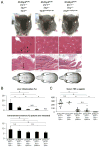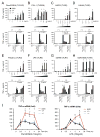Enhanced TLR-MYD88 signaling stimulates autoinflammation in SH3BP2 cherubism mice and defines the etiology of cherubism
- PMID: 25220465
- PMCID: PMC4177302
- DOI: 10.1016/j.celrep.2014.08.023
Enhanced TLR-MYD88 signaling stimulates autoinflammation in SH3BP2 cherubism mice and defines the etiology of cherubism
Abstract
Cherubism is caused by mutations in SH3BP2. Studies of cherubism mice showed that tumor necrosis factor α (TNF-α)-dependent autoinflammation is a major cause of the disorder but failed to explain why human cherubism lesions are restricted to jaws and regress after puberty. We demonstrate that the inflammation in cherubism mice is MYD88 dependent and is rescued in the absence of TLR2 and TLR4. However, germ-free cherubism mice also develop inflammation. Mutant macrophages are hyperresponsive to PAMPs (pathogen-associated molecular patterns) and DAMPs (damage-associated molecular patterns) that activate Toll-like receptors (TLRs), resulting in TNF-α overproduction. Phosphorylation of SH3BP2 at Y183 is critical for the TNF-α production. Finally, SYK depletion in macrophages prevents the inflammation. These data suggest that the presence of a large amount of TLR ligands, presumably oral bacteria and DAMPs during jawbone remodeling, may cause the jaw-specific development of human cherubism lesions. Reduced levels of DAMPs after stabilization of jaw remodeling may contribute to the age-dependent regression.
Copyright © 2014 The Authors. Published by Elsevier Inc. All rights reserved.
Conflict of interest statement
All authors state that they have no conflict of interest.
Figures







References
-
- Adachi O, Kawai T, Takeda K, Matsumoto M, Tsutsui H, Sakagami M, Nakanishi K, Akira S. Targeted disruption of the MyD88 gene results in loss of IL-1- and IL-18-mediated function. Immunity. 1998;9:143–150. - PubMed
-
- Akira S, Uematsu S, Takeuchi O. Pathogen recognition and innate immunity. Cell. 2006;124:783–801. - PubMed
-
- Berendsen AD, Olsen BR. Tankyrase loses its grip on SH3BP2 in cherubism. Cell. 2011;147:1222–1223. - PubMed
-
- Burns E, Bachrach G, Shapira L, Nussbaum G. Cutting Edge: TLR2 is required for the innate response to Porphyromonas gingivalis: activation leads to bacterial persistence and TLR2 deficiency attenuates induced alveolar bone resorption. J Immunol. 2006;177:8296–8300. - PubMed
Publication types
MeSH terms
Substances
Grants and funding
LinkOut - more resources
Full Text Sources
Other Literature Sources
Medical
Molecular Biology Databases
Miscellaneous

